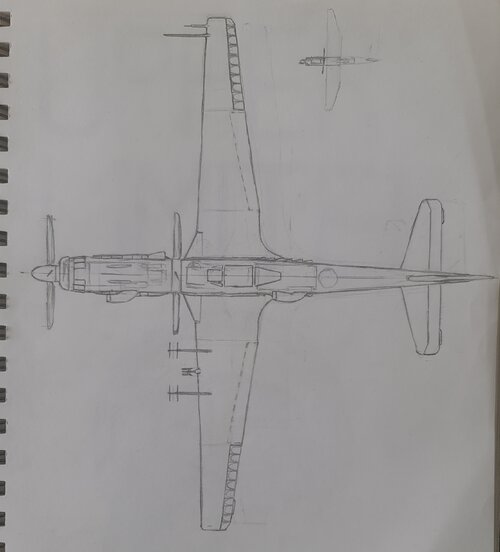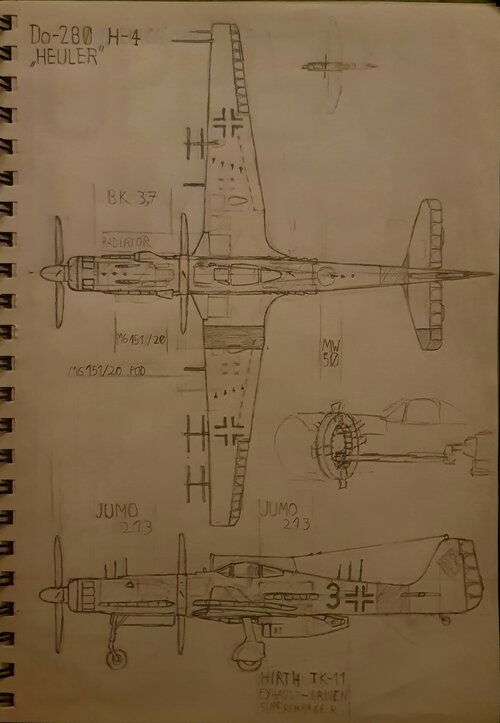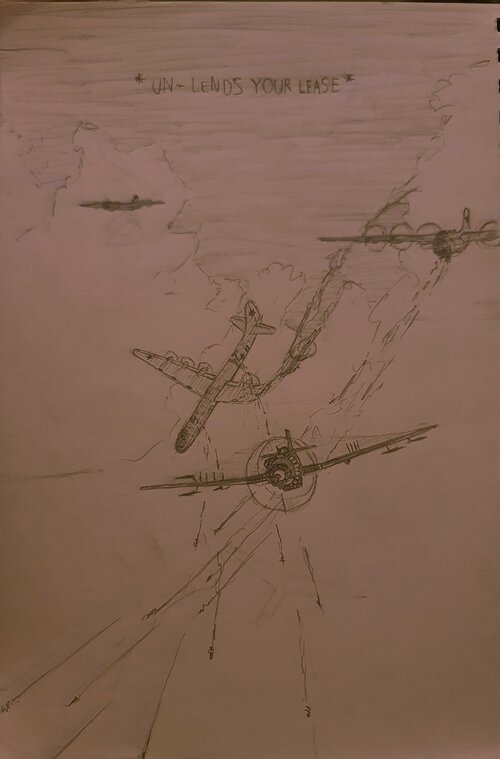F-32
ACCESS: Restricted
- Joined
- 30 January 2023
- Messages
- 13
- Reaction score
- 12
I am unsure if this is the right forum to post this, or if SecretProjects is even the right site, but if i understood correcrly this should be fine. If this post needs to be taken down just tell me and i will remove it!
I've been trying to come up with some at least partly believable combat aircraft that could've arisen from a continuation of the second world war. I'm currently trying to design a german high altitude twin engine interceptor. My main goal is to emulate how Focke-Wulf and later Dornier would design such a plane, based on a design specification for a bomber hunting aircraft of the kind and with horsepower/resource limitations taken into mind, so i figured you guys might be able to weigh in with what could and what couldn't work.
to get some specs out of the way:
- i estimate the center of mass to be somewhere near the leading edge of the wings, though i am unsure. The center of lift should be further enough in the rear if this is the case.
- it is powered by two jumo 213 engines, forward one cooled by an annular radiator while the rear one's cooling system is undecided. Both can be throttled separately and a single one can be run at a time for increased endurance. Air intakes are both on the left, though i'm considering removing the rear and adding an underbelly one, like the fw-190C's TK-11 supercharger in order to retain good performance at a higher altitude. I already have the ducting in place, that's why the front engine's exhaust is piped backwards through the annular propeller ring.
- propellers are both constant speed four bladed paddle props with similar blade shapes (rear ones are just made to fit onto the ring shaped base). They are geared separately and not linked in any way, though the rear one does have its rotation reversed via a gearbox on the crankshaft in order to mitigate torque.
- it is armed with two synchronised MG151/20 cannons mounted above the engine as well as a MK103 motorcannon, though it can be replaced with either another MG151 or a specialized anti-air BK 3,7. Wings have hardpoints for additional gun pods if needed and the forward right side of the cockpit has an internal hardpoint for an MK108 in a schrage musik configuration. there is also a centerline mounting point for a drop tank for increased endurance.
- the aircraft can be fitted with a wing mounted FuG-220 intercept radar (only two of four antennas visible due to the ortographic view) or a hull-fitted photoreconassiance camera. The FuG-220 is currently drawn with a FuG-202 included, but i am unsure of whether both are nessecary.
The idea behind the plane's design was to have a high altitude interceptor with enough horsepower to perform well with various ordinance and provisions, though due to germany's inability to break the 2000HP barrier, a twin engine design was chosen, inspired by the Do-335. The tandem engine configuration was used for both aerodnyamics and pre-existing coupled engines weren't utilised due to cooling issues. Though this is admittedly done partly for aesthetic reasons, contra rotation was dropped in favor of this unorthodox design to reduce maintanence costs and the added weight of the extension shafts and gearing. In reality, i assume the annular prop's gearbox would offset any and all mentioned advantages, though it is a fairly rare propeller configuration so i honestly do not know.
My current worries are:
- high altitude performance. While i believe the wing profile and overall fuselage shape to be fine, there's no denying that two engines weigh a decent bit, and that's sure to drag it downwards even if it has a decent top speed. Similarly, a bulky supercharger will help with engine tremendously, but i am unsure if fitting a single one in would really help if the other, less supercharged engine's performance will drop differently with an altitude increase.
- radar. I have no idea how a FuG-220 could be mounted onto a plane like this. Giving up the idea might be the most realistic course of action, but looking at the parts of a lichtenstein model still makes it seem like it could be crammed into a wing with fair ease. Another option would be to fit a berlin radar and it's dish into a wing pod, as america did with its naval fighters, though i don't know if the berlin radar would even be viable on a plane like this.
- airflow. I do not know how this propeller configuration's wash would affect performance. Turbulent airflow from the forward propeller is surely not going to increase the rear one's performance as they are too far apart to harness the contra-rotating effect, but on the other hand, the Do-335 with a relatively similar configuration was very fast despite this.
- Landing gear. There is currently three configurations that seem viable considerimg the aircraft's center of mass is inconveniently near the front of the wings. One is a standard tailwheel configuration where the inwards-closing front wheels are mechanically rotated forward when deployed to move them in front of the CoM, though this is unfortunately quite complex and still likely to cause a nose-down when braking. Another idea is to have a tandem wheel setup with wing mounted "training wheels", though this feels super unrealistic for the era. Lastly, a tricycle landing gear configuration could maybe be used here, though there is very little space for both the rear landing gears to fold in and the forward one too, though the forward gear could possibly be mounted off-center or rotate to be flat when retracted to remedy this.
Now, i've typed very much, i hope you guys found this interesting and if anyone has some holes to poke in the least believable elements, i'm all ears. I will be updating this thread with the blueprint when possible!

I've been trying to come up with some at least partly believable combat aircraft that could've arisen from a continuation of the second world war. I'm currently trying to design a german high altitude twin engine interceptor. My main goal is to emulate how Focke-Wulf and later Dornier would design such a plane, based on a design specification for a bomber hunting aircraft of the kind and with horsepower/resource limitations taken into mind, so i figured you guys might be able to weigh in with what could and what couldn't work.
to get some specs out of the way:
- i estimate the center of mass to be somewhere near the leading edge of the wings, though i am unsure. The center of lift should be further enough in the rear if this is the case.
- it is powered by two jumo 213 engines, forward one cooled by an annular radiator while the rear one's cooling system is undecided. Both can be throttled separately and a single one can be run at a time for increased endurance. Air intakes are both on the left, though i'm considering removing the rear and adding an underbelly one, like the fw-190C's TK-11 supercharger in order to retain good performance at a higher altitude. I already have the ducting in place, that's why the front engine's exhaust is piped backwards through the annular propeller ring.
- propellers are both constant speed four bladed paddle props with similar blade shapes (rear ones are just made to fit onto the ring shaped base). They are geared separately and not linked in any way, though the rear one does have its rotation reversed via a gearbox on the crankshaft in order to mitigate torque.
- it is armed with two synchronised MG151/20 cannons mounted above the engine as well as a MK103 motorcannon, though it can be replaced with either another MG151 or a specialized anti-air BK 3,7. Wings have hardpoints for additional gun pods if needed and the forward right side of the cockpit has an internal hardpoint for an MK108 in a schrage musik configuration. there is also a centerline mounting point for a drop tank for increased endurance.
- the aircraft can be fitted with a wing mounted FuG-220 intercept radar (only two of four antennas visible due to the ortographic view) or a hull-fitted photoreconassiance camera. The FuG-220 is currently drawn with a FuG-202 included, but i am unsure of whether both are nessecary.
The idea behind the plane's design was to have a high altitude interceptor with enough horsepower to perform well with various ordinance and provisions, though due to germany's inability to break the 2000HP barrier, a twin engine design was chosen, inspired by the Do-335. The tandem engine configuration was used for both aerodnyamics and pre-existing coupled engines weren't utilised due to cooling issues. Though this is admittedly done partly for aesthetic reasons, contra rotation was dropped in favor of this unorthodox design to reduce maintanence costs and the added weight of the extension shafts and gearing. In reality, i assume the annular prop's gearbox would offset any and all mentioned advantages, though it is a fairly rare propeller configuration so i honestly do not know.
My current worries are:
- high altitude performance. While i believe the wing profile and overall fuselage shape to be fine, there's no denying that two engines weigh a decent bit, and that's sure to drag it downwards even if it has a decent top speed. Similarly, a bulky supercharger will help with engine tremendously, but i am unsure if fitting a single one in would really help if the other, less supercharged engine's performance will drop differently with an altitude increase.
- radar. I have no idea how a FuG-220 could be mounted onto a plane like this. Giving up the idea might be the most realistic course of action, but looking at the parts of a lichtenstein model still makes it seem like it could be crammed into a wing with fair ease. Another option would be to fit a berlin radar and it's dish into a wing pod, as america did with its naval fighters, though i don't know if the berlin radar would even be viable on a plane like this.
- airflow. I do not know how this propeller configuration's wash would affect performance. Turbulent airflow from the forward propeller is surely not going to increase the rear one's performance as they are too far apart to harness the contra-rotating effect, but on the other hand, the Do-335 with a relatively similar configuration was very fast despite this.
- Landing gear. There is currently three configurations that seem viable considerimg the aircraft's center of mass is inconveniently near the front of the wings. One is a standard tailwheel configuration where the inwards-closing front wheels are mechanically rotated forward when deployed to move them in front of the CoM, though this is unfortunately quite complex and still likely to cause a nose-down when braking. Another idea is to have a tandem wheel setup with wing mounted "training wheels", though this feels super unrealistic for the era. Lastly, a tricycle landing gear configuration could maybe be used here, though there is very little space for both the rear landing gears to fold in and the forward one too, though the forward gear could possibly be mounted off-center or rotate to be flat when retracted to remedy this.
Now, i've typed very much, i hope you guys found this interesting and if anyone has some holes to poke in the least believable elements, i'm all ears. I will be updating this thread with the blueprint when possible!

Last edited by a moderator:








